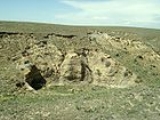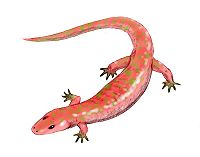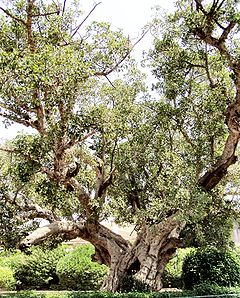
Laramie Formation
Encyclopedia

Cretaceous
The Cretaceous , derived from the Latin "creta" , usually abbreviated K for its German translation Kreide , is a geologic period and system from circa to million years ago. In the geologic timescale, the Cretaceous follows the Jurassic period and is followed by the Paleogene period of the...
age, named by Clarence King
Clarence King
Clarence R. King was an American geologist, mountaineer, and art critic. First director of the United States Geological Survey, from 1879 to 1881, King was noted for his exploration of the Sierra Nevada. He was born in Newport, Rhode Island.-Career:...
in 1876 for exposures in northeastern Colorado
Colorado
Colorado is a U.S. state that encompasses much of the Rocky Mountains as well as the northeastern portion of the Colorado Plateau and the western edge of the Great Plains...
, in the United States
United States
The United States of America is a federal constitutional republic comprising fifty states and a federal district...
.
The formation is exposed around the edges of the Denver Basin
Denver Basin
The Denver Basin, sometimes also called the Julesburg Basin, Denver-Julesburg Basin , or the D-J Basin, is a geologic structural basin centered in eastern Colorado in the United States, but extending into southeast Wyoming, western Nebraska, and western Kansas...
and ranges from 400–500 feet on the western side of the basin and 200–300 feet thick on the eastern side. The Laramie conformably overlies the Fox Hills Sandstone
Fox Hills Formation
The Fox Hills Formation is a Cretaceous geologic formation in the northwestern Great Plains of North America. It is present from Alberta on the north to Colorado in the south....
and unconformably underlies the Arapahoe Conglomerate. The formation can be divided into a lower unnamed member containing bedded sandstone
Sandstone
Sandstone is a sedimentary rock composed mainly of sand-sized minerals or rock grains.Most sandstone is composed of quartz and/or feldspar because these are the most common minerals in the Earth's crust. Like sand, sandstone may be any colour, but the most common colours are tan, brown, yellow,...
, clay
Clay
Clay is a general term including many combinations of one or more clay minerals with traces of metal oxides and organic matter. Geologic clay deposits are mostly composed of phyllosilicate minerals containing variable amounts of water trapped in the mineral structure.- Formation :Clay minerals...
, and coal
Coal
Coal is a combustible black or brownish-black sedimentary rock usually occurring in rock strata in layers or veins called coal beds or coal seams. The harder forms, such as anthracite coal, can be regarded as metamorphic rock because of later exposure to elevated temperature and pressure...
and an upper unnamed member composed predominately of 90 to 190 m of drab-colored mudstone, some sandstone, and thin coal beds. Nodular ironstone concretions occur in the mudstones that contain plant remains. The coal and clay were once economically important. The Laramie Formation was deposited on a coastal plain containing coastal swamp. Some of the material in the sandstones originated from silicic volcanoes far to the west.
Paleofauna
Fossil vertebrates from the Laramie Formation were among the first dinosaurs to be discovered in the American West (Carpenter and Young 2003). In 1873, Edward D. CopeEdward Drinker Cope
Edward Drinker Cope was an American paleontologist and comparative anatomist, as well as a noted herpetologist and ichthyologist. Born to a wealthy Quaker family, Cope distinguished himself as a child prodigy interested in science; he published his first scientific paper at the age of nineteen...
accompanied Ferdinand V. Hayden
Ferdinand Vandeveer Hayden
Dr. Ferdinand Vandeveer Hayden was an American geologist noted for his pioneering surveying expeditions of the Rocky Mountains in the late 19th century. He was also a physician who served with the Union Army during the Civil War.-Early life:Ferdinand Hayden was born in Westfield, Massachusetts...
, who was leader of the U.S. Geological and Geographical Survey of the Territories. The route of the expedition included eastern Colorado where Cope collected specimens in what is now the Laramie Formation along Bijou Creek on the east side of the Denver Basin (Cope, 1874).
Cope named three species of dinosaurs without description: Cinodon arctatus (later changed to Cionodon arctatus), Polyonax mortuarius and Agathaumas milo (later renamed Hadrosaurus occidentalis). These specimens are currently in the American Museum of Natural History. These specimens are very scrappy and the names no longer considered valid. Subsequent discoveries of dinosaurs occur through the formation, and include a nearly complete skull of Triceratops. Non-dinosaur vertebrates also occur (Carpenter 1979) .
List of Fossil Vertebrates (data from Carpenter 1979;; Hutchinson and Holroyd 2003)
Cartilaginous fishes
| Cartilaginous fishes of the Laramie Formation | ||||||
|---|---|---|---|---|---|---|
| Genus | Species | Location | Stratigraphic position | Abundance | Notes | |
Ischyriza |
cf. I. avonicola |
Sclerorhynchidae Sclerorhynchidae Sclerorhynchidae is an extinct family of cartilaginous fish from the Cretaceous and Paleogene belonging to the primitive Batoidea suborder Sclerorhynchoidea.-Sources:* accessed on 8/21/09... |
||||
Lonchidion |
L. selachos |
Lonchidiidae |
||||
Myledaphus |
M. bipartitus |
Rhinobatidae |
||||
Squatirhina |
S. americana |
Ginglymostomatidae |
||||
Bony fishes
| Bony fishes of the Laramie Formation | ||||||
|---|---|---|---|---|---|---|
| Genus | Species | Location | Stratigraphic position | Abundance | Notes | Images |
Amia Amia Amia, AMIA, or AMiA can refer to:*American Medical Informatics Association*Bowfin, a fish genus*Anglican Mission in the Americas*Asociación Mutual Israelita Argentina, a Jewish community center located in Buenos Aires, Argentina... |
Indeterminate |
Amiidae Amiidae Amiidae is a family of primitive ray-finned fish. Only one species, Amia calva, the bowfin, survives today, although additional species in all four subfamilies are known from Jurassic, Cretaceous, and Eocene fossils.... |
 |
|||
Astracosteus |
A. occidentalis |
Lepisosteidae |
||||
Amphibians
| Amphibian Amphibian Amphibians , are a class of vertebrate animals including animals such as toads, frogs, caecilians, and salamanders. They are characterized as non-amniote ectothermic tetrapods... s of the Laramie Formation |
||||||
|---|---|---|---|---|---|---|
| Genus | Species | Location | Stratigraphic position | Abundance | Notes | Images |
Albanerpeton Albanerpeton Albanerpeton is an extinct genus of salamander-like lissamphibian found in North America and Europe. Members of the genus have a robust head and neck which likely allowed them to actively burrow and they lived in a wide range of environments... |
Indeterminate |
Prosirenidae |
 |
|||
Lisserpeton Lisserpeton Lisserpeton is an extinct genus of prehistoric amphibian.-See also:* Prehistoric amphibian* List of prehistoric amphibians... |
L. bairdi |
Scapherpetontidae |
||||
Opisthotriton Opisthotriton Opisthotriton is an extinct genus of prehistoric salamanders that lived in North America between at least the Upper Cretaceous and the Paleocene.... |
O. kayi |
Batrachosauroididae |
||||
Scapherpeton Scapherpeton Scapherpeton is an extinct genus of prehistoric amphibian.-See also:* Prehistoric amphibian* List of prehistoric amphibians... |
S. tectum |
Scapherpetontidae |
||||
Turtles
| Turtle Turtle Turtles are reptiles of the order Testudines , characterised by a special bony or cartilaginous shell developed from their ribs that acts as a shield... s of the Laramie Formation |
||||||
|---|---|---|---|---|---|---|
| Genus | Species | Location | Stratigraphic position | Abundance | Notes | |
Adocus |
Indeterminate |
Adocidae |
||||
Basilemys |
cf. B. sinuosa |
Nanhsiungchelyidae |
||||
Compsemys Compsemys Compsemys is a genus of prehistoric turtle from the Late Cretaceous and Paleocene of North America. Although several species have been described, they are all considered synonyms of one species, C. victa, first described by Joseph Leidy in 1856... |
C. victa |
Pleurosternidae |
||||
Helopanoplia |
cf. H. distincta |
Trionychidae Trionychidae Trionychidae is a taxonomic family which comprises a number of turtle genera commonly known as softshells. They are also sometimes called pancake turtles. Softshells consist of some of the world's largest fresh water turtles, though many can adapt to living in highly brackish areas. Members of this... |
||||
Plesiobaena Plesiobaena Plesiobaena is an extinct genus of turtle which existed in the Belly River Formation, Canada during the late Cretaceous period . It was first named by Lambe, L. M. in 1972 and the type species is Plesiobaena antiqua.... |
cf. P. antique |
Baenidae Baenidae Baenidae is an extinct family of cryptodiran turtles.-External links:* http://www.nhm.org/site/sites/default/files/dinosaur_institute/pdf/NHM_DI_proytecto_dino_Erika_Canola_Baenidae_Turtle_experience.pdf... |
||||
Squamates
| Squamates of the Laramie Formation | ||||||
|---|---|---|---|---|---|---|
| Genus | Species | Location | Stratigraphic position | Abundance | Notes | |
Odaxosaurus |
O. piger |
Anguidae Anguidae The Anguidae is a large and diverse family of lizards native to the northern hemisphere. The group includes the slowworms, glass lizards, and alligator lizards, among others. Anguidae is divided into three subfamilies and contains 94 species in eight genera. Their closest living relatives are the... |
||||
Crocodilians
| Crocodilians of the Laramie Formation | ||||||
|---|---|---|---|---|---|---|
| Genus | Species | Location | Stratigraphic position | Abundance | Notes | Images |
Borealosuchus Borealosuchus Borealosuchus is an extinct genus of crocodilian that lived from the Late Cretaceous to the Eocene in North America. It was named by Chris Brochu in 1997 for several species that had been assigned to Leidyosuchus. The species assigned to it are:B... ? |
Indeterminate |
|||||
Dinosaurs
| Dinosaur Dinosaur Dinosaurs are a diverse group of animals of the clade and superorder Dinosauria. They were the dominant terrestrial vertebrates for over 160 million years, from the late Triassic period until the end of the Cretaceous , when the Cretaceous–Paleogene extinction event led to the extinction of... s reported from the Laramie Formation |
||||||
|---|---|---|---|---|---|---|
| Genus | Species | Location | Stratigraphic position | Material | Notes | Images |
Ceratopsipes Ceratopsipes Ceratopsipes is an ichnogenus of dinosaur footprint.-References:... |
C. goldenensis |
Ceratopsidae Ceratopsidae Ceratopsidae is a speciose group of marginocephalian dinosaurs including Triceratops and Styracosaurus... |
  |
|||
Dromaeosaurus Dromaeosaurus Dromaeosaurus was a genus of theropod dinosaur which lived during the Late Cretaceous period , sometime between 76.5 and 74.8 million years ago, in the western United States and Alberta, Canada. The name means 'running lizard'.... |
Indeterminate |
Dromaeosauridae Dromaeosauridae Dromaeosauridae is a family of bird-like theropod dinosaurs. They were small- to medium-sized feathered carnivores that flourished in the Cretaceous Period. The name Dromaeosauridae means 'running lizards', from Greek dromeus meaning 'runner' and sauros meaning 'lizard'... |
||||
Edmontonia Edmontonia Edmontonia was an armoured dinosaur, a part of the nodosaur family from the Late Cretaceous Period. It is named after the Edmonton Formation , the unit of rock it was found in.-Description:... |
Indeterminate |
Nodosauridae Nodosauridae Nodosauridae is a family of ankylosaurian dinosaurs, from the Late Jurassic to the Late Cretaceous Period of what are now North America, Asia, Antarctica and Europe.-Characteristics:... |
||||
Edmontosaurus Edmontosaurus Edmontosaurus is a genus of crestless hadrosaurid dinosaur. It contains two species: Edmontosaurus regalis and Edmontosaurus annectens. Fossils of E. regalis have been found in rocks of western North America that date from the late Campanian stage of the Cretaceous Period 73 million years ago,... |
E. annectens |
Hadrosauridae |
||||
E. regalis |
Hadrosauridae |
|||||
Ornithomimus Ornithomimus Ornithomimus is a genus of ornithomimid dinosaur from the Late Cretaceous Period of what is now North America.In 1890 Ornithomimus velox was named by Othniel Charles Marsh on the basis of a foot and partial hand from the Maastrichtian Denver Formation. Another seventeen species have been named since... |
O. minutus |
"Partial metatarsals II-IV." |
The specimens are now lost. |
|||
Paronychodon Paronychodon Paronychodon was a theropod dinosaur genus. It is a tooth taxon, considered dubious because of the fragmentary nature of the fossils, which include "buckets" of teeth but no other remains... |
Indeterminate |
|||||
Thescelosaurus Thescelosaurus Thescelosaurus was a genus of small ornithopod dinosaur that appeared at the very end of the Late Cretaceous period in North America. It was a member of the last dinosaurian fauna before the Cretaceous-Tertiary extinction event around 65.5 million years ago... |
T. neglectus |
Thescelosauridae |
||||
Torosaurus Torosaurus Torosaurus is a genus of ceratopsid dinosaur that lived during the late Cretaceous period , between 70 and 65 million years ago. It possessed one of the largest skulls of any known land animal. The frilled skull reached in length... |
T. latus |
Ceratopsidae Ceratopsidae Ceratopsidae is a speciose group of marginocephalian dinosaurs including Triceratops and Styracosaurus... |
||||
Triceratops Triceratops Triceratops is a genus of herbivorous ceratopsid dinosaur which lived during the late Maastrichtian stage of the Late Cretaceous Period, around 68 to 65 million years ago in what is now North America. It was one of the last dinosaur genera to appear before the great Cretaceous–Paleogene... |
T. horridus |
Ceratopsidae Ceratopsidae Ceratopsidae is a speciose group of marginocephalian dinosaurs including Triceratops and Styracosaurus... |
||||
Tripriodon |
T. operatus |
|||||
Tyrannosaurus Tyrannosaurus Tyrannosaurus meaning "tyrant," and sauros meaning "lizard") is a genus of coelurosaurian theropod dinosaur. The species Tyrannosaurus rex , commonly abbreviated to T. rex, is a fixture in popular culture. It lived throughout what is now western North America, with a much wider range than other... |
T. rex |
Tyrannosauridae Tyrannosauridae Tyrannosauridae is a family of coelurosaurian theropod dinosaurs which comprises two subfamilies containing up to six genera, including the eponymous Tyrannosaurus. The exact number of genera is controversial, with some experts recognizing as few as three... |
||||
Mammals
| Mammal Mammal Mammals are members of a class of air-breathing vertebrate animals characterised by the possession of endothermy, hair, three middle ear bones, and mammary glands functional in mothers with young... s of the Laramie Formation |
||||||
|---|---|---|---|---|---|---|
| Genus | Species | Location | Stratigraphic position | Abundance | Notes | |
Gypsonictops |
Indeterminate |
Leptictidae |
||||
Meniscoessus Meniscoessus Meniscoessus is a genus of extinct mammal from the Upper Cretaceous Period of what is now North America. It lived toward the end of the "age of the dinosaurs" and was a member of the extinct order Multituberculata. It lies within the suborder Cimolodonta and family Cimolomyidae.The genus... |
Indeterminate |
Cimolodontidae Cimolodontidae Cimolodontidae is a family of fossil mammals within the extinct order Multituberculata. Representatives are known from the Upper Cretaceous and Paleocene of North America. There is some doubt as to whether Cimolodon is within this taxon. If not, the name of the family would still be valid... |
||||
cf. Mesodma Mesodma Mesodma is an extinct genus of mammal, a member of the extinct order Multituberculata within the suborder Cimolodonta, family Neoplagiaulacidae. It lived during the upper Cretaceous and Paleocene Periods of what is now North America... |
Indeterminate |
Neoplagiaulacidae Neoplagiaulacidae Neoplagiaulacidae is a family of mammal within the extinct order Multituberculata. Fossil remains are known from the Upper Cretaceous through the Eocene. Representatives have been found in North America, Europe and Asia.... |
||||
Flora
Fossil pollenPollen
Pollen is a fine to coarse powder containing the microgametophytes of seed plants, which produce the male gametes . Pollen grains have a hard coat that protects the sperm cells during the process of their movement from the stamens to the pistil of flowering plants or from the male cone to the...
(palynomorphs) include bryophyte and pteridophyte spores, gymnosperm pollen, and abundant angiosperm pollen, including Aquilapollenites striatus, Ilexpollenites compactus, Interpollis cf. I. supplingensis, and Tricolpites interangulus. The palynomorphs indicate an early Maastrichtian age (68-69 mya), which is supported by magnetostratigraphy
Magnetostratigraphy
Magnetostratigraphy is a geophysical correlation technique used to date sedimentary and volcanic sequences. The method works by collecting oriented samples at measured intervals throughout the section. The samples are analyzed to determine their characteristic remanent magnetization , that is, the...
. Magnetostratigraphy also shows that the Laramie Formation becomes progressively younger eastward as deposition followed the regression of the Western Interior Seaway
Western Interior Seaway
The Western Interior Seaway, also called the Cretaceous Seaway, the Niobraran Sea, and the North American Inland Sea, was a huge inland sea that split the continent of North America into two halves, Laramidia and Appalachia, during most of the mid- and late-Cretaceous Period...
.
Fossil leaves are abundant, especially in the shales and sandstones associated with coal. Dicot angiosperms dominate, with lesser amounts of ferns, palms, and herbaceous lycopods. Interestingly, conifers are rare. Common plants include “Ficus” planicostata, “Myrica” torreyi, Sabalites sp., Platanites marginata, and Marmarthia pearsonii.
| Flora Flora Flora is the plant life occurring in a particular region or time, generally the naturally occurring or indigenous—native plant life. The corresponding term for animals is fauna.-Etymology:... of the Laramie Formation |
||||||
|---|---|---|---|---|---|---|
| Genus | Species | Location | Stratigraphic position | Abundance | Notes | Images |
Aquilapollenites |
Aquilapollenites striatus |
  |
||||
“Ficus Ficus Ficus is a genus of about 850 species of woody trees, shrubs, vines, epiphytes, and hemiepiphyte in the family Moraceae. Collectively known as fig trees or figs, they are native throughout the tropics with a few species extending into the semi-warm temperate zone. The Common Fig Ficus is a genus of... ” |
“Ficus” planicostata |
|||||
Ilexpollenites |
Ilexpollenites compactus |
|||||
Interpollis |
Interpollis cf. I. supplingensis |
|||||
Marmarthia |
Marmarthia pearsonii |
|||||
“Myrica Myrica Myrica is a genus of about 35–50 species of small trees and shrubs in the family Myricaceae, order Fagales. The genus has a wide distribution, including Africa, Asia, Europe, North America and South America, and missing only from Australasia... ” |
“Myrica” torreyi |
|||||
Platanites |
Platanites marginata |
|||||
Sabalites |
Sabalites sp. |
|||||
Tricolpites |
Tricolpites interangulus |
|||||
Uranium
Uranium deposits occur in sandstones of the Laramie Formation in Weld County, ColoradoWeld County, Colorado
As of the census of 2000, there were 180,936 people, 63,247 households, and 45,221 families residing in the county. The population density was 45 people per square mile . There were 66,194 housing units at an average density of 17 per square mile...
. (See Uranium mining in Colorado)

